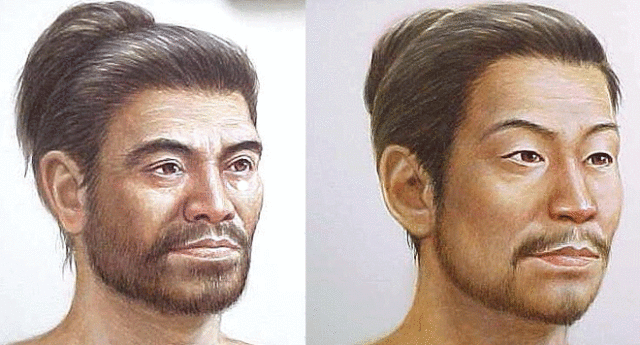Jomon (left) and Yayoi faces. Image: theapricity.com
OUR MULTI-COLUMN REVIEW of the origins of the Japanese people (this is #9 in the series) only briefly considered the decline of the Ainu, the native people of Japan, and their predecessors. So today, we revisit the question of why the Japanese of today look more “Yayoi” (ancient rice farmers from Korea) than “Jomon” (aboriginal Japanese). Certainly the Yayoi had the advantage of metal weapons. But does that alone explain it?
I believe the answer lies in the parallel of Pacific Northwest history. Here, as in Japan, former hunting and gathering peoples have also found their shores invaded by increasing numbers of agricultural peoples originating from the vast continent of Eurasia. Yet while Seattle has been occupied by Eurasians for only 166 years, I can go for months without seeing a Native American face.
One reason this is so is that on a world public-health scale, Africa and Eurasia stand out as continents of constantly intermingling peoples and animals. Thus, both foster the development and spread of diseases.
As one example, today, we continue to live in fear of avian influenza strains originating in China. There, such viruses jump from ducks to pigs, as the two animals live in close proximity on family farms. From pigs, the viruses easily leap to their anatomically similar human owners.
The history of Northwest Native Americans differs from that of the Ainu mainly in the timing of the first contact between Eurasian and native peoples. The first European ship landed in this region in 1774. The relative lateness of that encounter matters because in the Northwest, literacy was widespread enough among the new arrivals that many could set down on paper how they witnessed Native Americans vaporize before their eyes.
William Duncan, a missionary, was one such observer. He recorded the death of a young native girl near Victoria, BC, Canada, in 1862. He first visited the sick girl on July 21, where she had been isolated in the forest since July 18 after showing signs of disease. She had “only a few leaves on the branch of a tree for her tent & her old grandmother to attend her.” The good man left her medicine and rice. Two days later, “Poor Athlthnol had bid her grandmother leave her as she felt she would die. She had also crept farther into the brush & laid down under a tree—thinking perhaps [her grandmother] will come to bury her when she dies. I stood on the rocky beach & called aloud—after some time the poor girl responded with a deadly hoarse voice & the grandmother made her appearance from a little distance. The poor old creature said she was very much afraid & so had got away. She then shouted for the poor girl to come. She obliged & sat where I could see her. She was spitting continually blood & pus & also blood had come from her nose. Her face was a sad sight. How sudden a change in a few days. I pointed her again to God & left her with the feeling that I should see her again no more.” The next day “Poor Athlthnol is dead & left to be eaten by the wolves. No body dares bury her.”*
The key diseases that felled Northwest Native Americans, and other similarly isolated populations lacking builtup immunities, were smallpox, measles, and malaria. Athlthnol had smallpox. In a series of repeated, welldocumented epidemics, the three wiped out Northwest natives by the thousands. This is the reason Lewis and Clark noted many empty villages along the lower Columbia River in 1805-1806. Commonly, the dead were left as skeletons in their bunks, for no one was left to bury them.
Smallpox facial scarring is present in Egyptian mummies. It reached China by the first century AD. The Yayoi immigrants could not have helped carry it and other infectious diseases aboard ships bound for Japan, for the newly infected lack symptoms. A smallpox epidemic in AD 735-737 may have killed one third of the Japanese population. Throughout Japanese history, the dead must have been disproportionately Ainu.
*From “The Coming of the Spirit of Pestilence, Introduced infectious diseases and population decline among Northwest Coast Indians, 1774-1874,” Robert Boyd, UW Press, 1999, p. 198.


Smallpox in Japan, ca AD 1720. Images: Wikipedia.com







